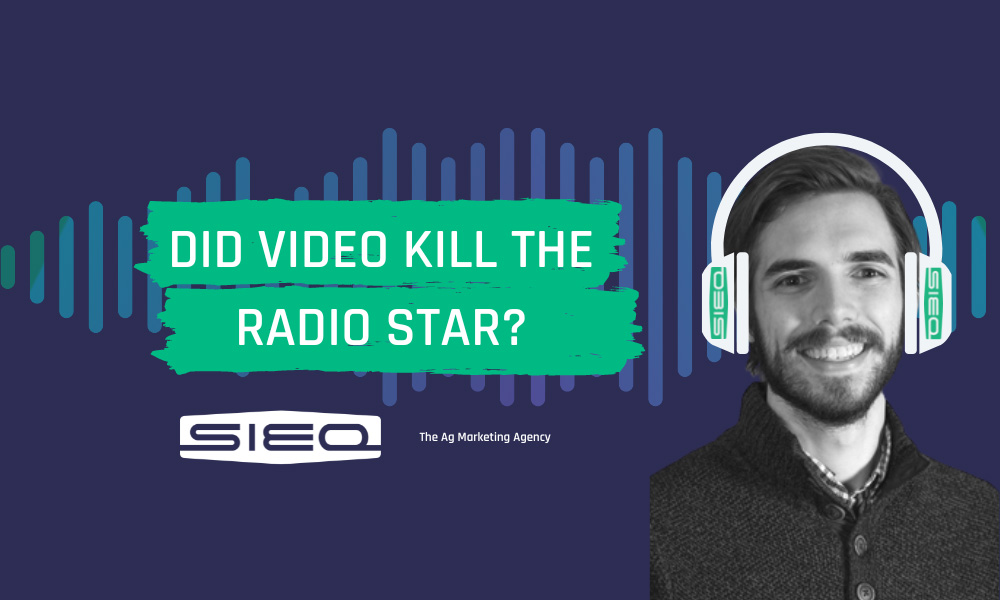Video Killed the Radio Star...or Did It?

Prefer to watch your content? No problem! Take in this blog written and presented by SI EQ Account Executive, Nik Hiles here on our YouTube Channel.
RADIO IS DEAD!? Ok, no, BUT audio medias have rapidly evolved over the last 30 years. We have gone from relying on radio and CDs for our audio entertainment to streaming whatever we want whenever. With a shift this big, advertisers need to ensure that we adapt and prepare for what is next.
So What Is Audio Advertising?
A paid message from an identifiable company promoting a product or service via any form of audio broadcast, stream, live audience, or podcast. Audio advertising includes adverts on radio, talk shows, streaming platforms like Spotify, and podcasts.The Rise Of Digital Audio Advertising
So before we dive into the ongoings of today’s audio advertising landscape, let’s take a step back and see what has changed in the last 30 years.
Previous to the 90s, radio dominated audio advertising! Yes, companies could sponsor a tape or CD - heck, I remember Chick-fil-A giving out tapes in their children's meals. But truly, audio advertising was radio.
In the 2000s, digital audio options began to rise but struggled due to technological limitations, mainly device capabilities and internet connectivity.
Fun Facts:
The iPod was first introduced in 2001 and led to today’s ability to bring digital audio with you wherever you go.
In 2004 the term podcast (a combination of iPod and broadcast) was first coined!
Spotify was founded in 2006
Soundcloud was founded in 2007
Though Spotify was founded in 2006, digital audio truly took off in 2010 and evolved into what we know today! With the release of 4G cellular connection in 2010 to the United States, more people could stream video and audio on the go (without buffering). This allowed platforms like Spotify, Soundcloud, and YouTube to be used more often than ever before.
One key thing to acknowledge when looking at audio media is the listener’s ability to do something else while listening. Unlike video, listeners are free to move around the house, drive, and go on runs without missing any content.
The 5 Types of Audio Ads
With the acceleration of digital audio, today’s advertisers have access to five types of audio advertising - radio, live audience reads, digital audio, digital audio with video support, podcast ads.
#1 Radio
Believe it or not, Radio is still a viable option for your marketing plans. It reaches a large audience for cheap and works in rural areas where internet connectivity is not guaranteed.
Radio also opens up possibilities for adlib ads where radio personalities perform a live loose read, in their own style, of advert talking points performed by radio personalities. This ad type extends the radio personality’s following to your brand, making your message more receptive.
The major con of radio advertising is the limited reporting available, as media vendors can only share if the ad runs and not how it performed.
#2 Live Audience
Think Friday Night Football or Symphony Performance - the announcer reads a script saying something similar to “Thank you to tonight's sponsor Jimmy’s Tractors & Equipment, your one-stop shop for all things tractors.” Live audience reads can be a great way to speak to a community and raise awareness because the advertisement is happening in real-time, tied to a live event.
#3 Digital Audio Ads
Music, talk shows, podcasts - any kind of audio listened to through an internet connection. Using new platforms like Spotify, advertisers can see reporting, unlike radio, and take advantage of audience targeting.
Digital Audio Facts:
30% more time is spent on digital audio platforms when compared to traditional radio.*
70% of the US population listens to digital audio*
Spend Guarantees Accurate Reach
Streaming Ad Insertion - allowing for ads to be placed during the stream
*Stats come from Spotify
#4 Digital Audio Ads With Video Support
Content such as podcasts and concert recordings where the content doesn’t rely on the visuals can be considered an audio ad.
The video streaming platform YouTube ranks as the most popular music streaming platform in America. Consumers (like myself) will stream music from YouTube on their laptops while working on a different tab. They MAY look at the visuals every once in a while, but their enjoyment of the content is not harmed if their eyes are not focused on the video.
Apple Music does NOT offer ads.
#5 Podcast Ads
According to Spotify, the number one podcast platform, 1/3 of Americans listen to podcasts on average 40 minutes per day. These figures can be tied to consumers’ work commutes, multitasking, and screen fatigue, where listeners are tired of staring at screens.
Listener survey results from Spotify’s survey say:
80% agree podcasts are a great way to learn
63% trust podcasts to educate them
75% give their full attention to their favorite podcasts
40% receptive to audio advertisements (compared to 17% of TV viewers)
So Does Audio Advertising Matter?
Yes - yes - yes! Audio advertising matters! Audio is one of the largest and most powerful mediums in the United States providing advertisers an amazing opportunity to reach their target audience as they enjoy their favorite songs, commute to work, and go for their weekly run.
In fact in some cases, in political seasons where CPMs on streaming and linear TV are at their highest, we receive more actions from digital audio efforts than we do video content.
What platforms should I get on?
This question (of course) depends on your goals, target geography, and the size of your marketing budget. As you just read, there are a lot of great platforms, each with its own advantages and disadvantages, so one platform does not fit all.
For a free consultation on how SI EQ can help you achieve your marketing goals through audio advertising, email Alex Hanes at [email protected], or if you are already a partner with SI EQ for your marketing, contact your marketing account executive for more information.



